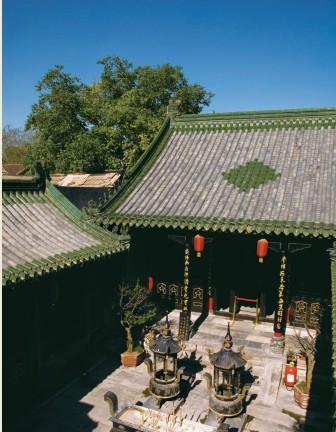
Jinan people in old times had lots of faiths, so there were a variety of temples and churches in JinanCity. It can be said that if there is a street there must be a temple, so that various temples gather together in alleys. A twist of burning incense, accompanying by sound of praying drifts in and out of the old city.
The most typical one is the General Temple Street in Ximen, which is 180m long in east-west direction. On the north side of the road there originally coexisted four Chinese and Western temples from east to west being ChenghuangTemple, GeneralTemple, CiyunTemple, and the Catholic Church in turn.
Inside General Temple is a shrine to Liu Meng, a general in the Qing Dynasty (A.D.1644 1911), a Jinan native, who read books and studied martial arts when he was young. During the period of the Emperor Yongzheng (A.D.1678~1735), he joined the army and defeated the enemy by leading his soldiers, and was known as the ever-victorious general. In order to reward him for his love of his country and loyalty to the emperor, Emperor Yongzheng issued an edict to Jinan Government to build this temple for him.
In the past, FuchenghuangTemple was located to the east of the GeneralTemple. With the longest history, it was located on Donghua Street in the east of the city. The one with three compartments, single eave, nine ridges, and green-tiles gate was the largest top ridge temple in the old JinanCity. On the top of the door are carved four characters Du Cheng Huang Miao (DuchenghuangTemple).
In the middle section of the General Temple Street stands another TaoistTemple called CiyunTemple, which was constructed in the twenty-fifth year of the Emperor Daoguang (1845). It is small and now only possesses the ceremony door, main shrine, and side shrine. Currently, the gable and the tile roof of the main shrine still exist. The ceremony door has three eaves with brasses as its cover, in the middle is the corridor with a stone arch, and on the top of the door is a stele carved with three characters Ci Yun Guan (Ciyun Temple). FuchenghuangTemple and CiyunTemple had been in the charge of the same priest for a long time.
Catholicism was initially introduced to Jinan in the 17th century and began to spread from the GeneralTemple. In the eighth years of the Emperor Shunzhi (1651) in the Qing Dynasty, the Spanish clergyman Jia Bo er purchased one building and built the first Catholic Church in Jinan. In the second year of Emperor Yongzheng (1724), the local people who were opposed to foreign religion dismantled the church. In 1861, the French bishop, Jiang Leisi visited Shandong and asked the Qing Government to reconstruct the Catholic Church in the General Temple and won approval. The construction of the church began at 1864 and lasted for two years. The church was called the sanctuary by people, because it was solemn and dignified, and the top of it is designed with colorful decoration of religious subjects.
In the past, regardless of urban and rural areas in China, the places for worshiping the immortals were mostly Tudi (Land Deity) Temple and GuandiTemple (temple for Guan Yu, a famous general in the later Eastern Han Dynasty). Jinan is not an exception. On many alleys such as Lotus Street, Gaodusi Alley, and Guyishi Street stand Guandi Temples. Jinan has very many temples. The one that possesses the highest standard is GuandiTemple, which is at east end of Houzaimen Street, on the north side. This temple covers an area of 7.2 mu (1 mu 667 square meters).
It has been the street and market style of China that there is unity of temple and market or market in front and temple at back . For example, Fuzi Temple in Nanjing, Guanqian Street in Suzhou, and Chenghuang Temple in Shanghai, are all palces where business concentrates. It is just because of the Fuxue Wen Temple and Guandi Temple at the north end, Longshen Temple on the east side of the central section, Nunnery on the west side of the road that the Lotus Street became more and more prosperous.
The WenTemple on the Lotus Street is also the place where Jinan Government established a traditional Chinese culture school in ancient times. In order to tell it from the WenTemple in LichengCounty, Jinan people called this place FuxueWenTemple. Beginning from the north end of the Lotus Street in the south and ends at Daming Lake in the north, the temple was established in the Emperor Xining period of the North Song Dynasty (A.D.1068~1078), and has now become the oldest and biggest building cluster in the old city.
Editor Melinda





